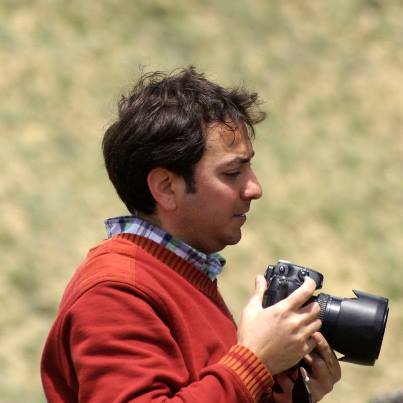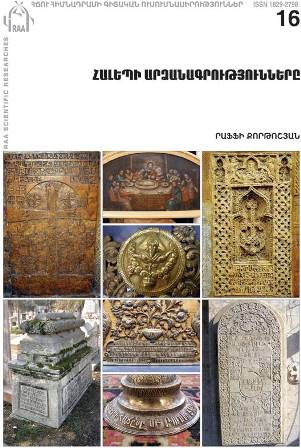
 Interview on the occasion of the publication of the book: “The Inscriptions of Aleppo” (673 pages, Yerevan, 2013).
Interview on the occasion of the publication of the book: “The Inscriptions of Aleppo” (673 pages, Yerevan, 2013).
Azad-Hye
Raffi Kortoshian was born in Aleppo in 1979 and studied in the Haygazian elementary school and continued his education in Karen Jeppe Armenian High School. After graduating from the High School he studied architecture at the University of Aleppo. In 2006 he moved to Armenia and started working at the ?Research on Armenian Architecture?, where he continues to work until today.
Azad-Hye had this interesting interview with him:
– How long did it take for you to prepare this monumental and detailed volume? Were there any practical difficulties?
Back in 2004 I developed interest in the geographical places mentioned on the gravestones of the survivors of the Armenian Genocide in Aleppo cemetaries. I thought it was important to photograph them for documentation purposes, but for different reasons I could not begin the work then.
In 2006 when I moved to Armenia, I told Mr. Samvel Karapetyan, the Director of ?Research on Armenian Architecture?, about my idea. He was inspired and encouraged me to undertake this project, proposing to explore all the Armenian inscriptions available in Aleppo.
The recording of the inscriptions were carried on from 2006-2008. All inscriptions that were accessible to us were recorded, regardless of their size, content and condition. Exceptions were made for the inscriptions belonging to current graveyards of the three Armenian communities (Orthodox, Catholic and Protestant) located in Sheikh Maqsud area. Having in mind the big number of gravestones available there, we recorded only those tombstones that showed a geographical name, besides the usual name and surname of the person.
During the period 2008-2013 I carried on the design and preparation of the book. The work presents mainly the inscriptions found in Aleppo's Armenian churches and cemeteries, shedding light for the first time on the inscriptions on gravestones belonging to survivors of the Armenian Genocide, who were born in different places in the Othoman Empire (including Western Armenia).
The material covers more than 2500 inscriptions belonging to the following places: The Church of the Holy Mother of God, Holy Forty Martyrs Cathedral and the adjacent buildings in Salibeh, the Cathedral of Our Mother of Reliefs, Emmanuel Church, Surp Krikor Lusavorich Church (Saint Gregory the Illuminator Church), Surp Kevork Church (Saint George Church), Surp Hagop Church (Saint Jacob of Nisibis Church), Holy Trinity Church, the new Church of the Holy Mother of God, Bethel Church, the Armenian Orthodox, Evangelical and Catholic graveyards in Sheikh Maqsud, Hokedoun, Old Peoples? House and several residences.
– From the time of the publication of a book by Archbishop Ardavazt Surmeyan (before WWII) until your publication, were there any other works that dealt with the same topic?
Thus far, the stone inscriptions in Aleppo have been studied only by Archbishop Ardavazt Surmeyan (with some omissions). With a broader aspect of research, my current publication has come to complement the work that has been done in this domain.
– Are there any inscriptions which you believe have been left out of this study for some reason or another?
The inscriptions belonging to some Armenian-built houses in the old district of Aleppo have remained out, because the large number of these houses, during the period of the preparation of this research, were owned by Muslim Arabs and the inscriptions were in fact located inside their homes. In order to study them permission was necessary, which unfortunately we could not get.
– Are there other places in Syria where someone could find a wealth of historical materials on the same topic?
There are many locations all around Syria related to the topic of this research. We have carried on similar work in other places during the period of 2010-2011, which we intend to present in another work.
– How much satisfaction did this book which has been prepared before the Syrian crisis and was published these days, granted you, in the sense that today it would have been impossible to carry on such field work.
Fortunately, about 90 percent of the Armenian monuments in Syria were photographed and recorded by us during the period 2006-2011, but we would have felt more satisfaction if the Syrian Armenian monuments were in safe condition. For this reason we have dedicated this work to those who selflessly, in these difficult times, safeguard the Armenian spiritual and cultural values in Aleppo.
The book can be download completely in PDF format from this link (size 89MB): http://www.raa-am.com/Halep/Halep_poqr.pdf
Website of “Research on Armenian Architecture”: www.raa.am
 TEXT IN ARMENIAN
TEXT IN ARMENIAN
Հարցազրոյց ?Հալէպի Արձանագրութիւնները? մեծածաւալ հատորի հեղինակ Րաֆֆի Քորթոշեանի հետ:
Ազատ-Հայ
– Վեց հարյուր էջերէ աւելի բաղկացած ձեր կոթողային ու մանրակրկիտ աշխատութիւնը որքա՞ն ժամանակ խլեց ձեզմէ եւ ի՞նչ հանգրուաններէ անցաւ անոր պատրաստութիւնը: Կայի՞ն գործնական դժուարութիւններ:
Դեռևս 2004 թ. Հալեպի գերեզմանոցում տեսնելով Մեծ եղեռնը վերապրողների հիշատակին կանգնեցված տապանաքարերի արձանագրություններում առկա տեղանունները, մտածեցի, որ դրանք անհրաժեշտ են լուսանկարել արխիվավորման նպատակով, սակայն ինչ-ինչ պատճառներով չկարողացա գործին ձեռնամուխ լինել:
2006 թ., երբ տեղափոխվեցի Հայաստան, իմ միտքը հայտնեցի ?Հայկական ճարտարապետությունն ուսումնասիրող? հիմնադրամի տնօրեն Սամվել Կարապետյանին, նա ևս ոգեշնչվեց և ոգևորեց ինձ կատարելու այս աշխատանքը, սակայն առաջարկելով ուսումնասիրել ամբողջ Հալեպի հայկական արձանագրությունները:
2006-2008 թթ. ընթացքում իրականացրեցի Հալեպի արձանագրությունների հավաքման գործը, որի կատարման համար առաջնորդվել ենք հետևյալ սկզբունքով՝ անխտիր հավաքել և ներկայացնել մեզ հասանելի բոլոր արձանագրությունները՝ անկախ ծավալից, բովանդակությունից կամ պահպանվածության աստիճանից: Բացառություն են կազմում միայն Շեխ-Մագսուդի երեք համայնքներին պատկանող գերեզմանատների արձանագրությունները: Նկատի ունենալով վերջիններիս խիստ մեծ քանակը՝ հավաքածուում ներգրավել ենք այնպիսի տապանագրեր, որտեղ, բացի հանգուցյալի անուն-ազգանունից, արձանագրված է եղել նաև տեղանուն:
2008-2013 թթ. ընթացքում կատարեցի գրքի մշակման և պատրաստման աշխատանքները: Աշխատությունը հիմնականում ներկայացնում է Հալեպի հայկական եկեղեցիների և գերեզմանոցների արձանագրությունները: Առաջին անգամ ուշադրության են արժանացել Օսմանյան կայսրության զանազան գավառներում (այդ թվում նաև Արևմտյան Հայաստանում) ծնված, 1915 թ. ցեղասպանությունը վերապրած և Հալեպում հաստատված հայերի տապանաքարերի արձանագրությունները: Այսպիսով, հատորն ամփոփում է Հալեպի Սլեյբե թաղամասի Սբ. Աստվածածին, Սբ. Քառասնից Մանկանց, դրանց շրջաբակի և կից կառույցների, Սբ. Կուսին Մոր Օգնությանց, Էմմանուել, Սբ. Գրիգոր Լուսավորիչ, Սբ. Գևորգ, Սբ. Հակոբ, Սբ. Երրորդություն, Սբ. Աստվածածին նոր, Բեթել եկեղեցիների, Ազիզիեի ազգային, Շեխ-Մագսուդի հայ առաքելական, հայ ավետարանական, հայ կաթողիկե գերեզմանատների, Հոգետան, ծերանոցի և բնակելի մի քանի տների ավելի քան 2500 արձանագրություն:
– Սուրմէյեան Սրբազանէն մինչեւ ձեր գիրքին հրատարակութիւնը եղա՞ծ են այլ գործեր այս նոյն բնագաւառին մէջ:
Հալեպի վիմագրական ժառանգությունը ցարդ ուսումնասիրել է միայն Արտավազդ արք. Սյուրմեյանը (ունի որոշ բացթողումներ): Նյութի առավել լայն ընդգրկմամբ սույն աշխատությունը գալիս է լրացնելու այս ոլորտում կատարված աշխատանքը:
– Կա՞ն արձանագրութիւններ որոնք կը խորհիք թէ դուրս մնացած են ձեր աշխատութենէն այս կամ այն պատճառներով:
Աշխատությունից դուրս են մնացել Հալեպի հին թաղամասերում գտնվող հայաշեն տների արձանագրությունները, քանի որ տների մեծ մասն ուսումնասիրության ընթացքում արդեն պատկանում էին այլազգիներին, իսկ արձանագրությունները հիմնականում գտնվում էին տների ներսում: Դրանք ուսումնասիրելու համար անհրաժեշտ էր ստանալ սեփականատերերի թույլտվությունը, որը, ցավոք, մեզ չի հաջողվել:
– Սուրիոյ տարածքին կա՞ն այլ վայրեր որ հարուստ պատմական նիւթ կրնան հայթայթել նոյն թեմայով:
Սիրիայի ամբողջ տարածքում կան խնդրին առչնվող բազմաթիվ բնակավայրեր, որոնցում 2010-2011 թթ. ընթացքում ևս կատարել ենք հավաքչական աշխատանքներ և մտադիր ենք դրանք ներկայացնել մեկ այլ աշխատությամբ:
– Սուրիական տագնապէն առաջ պատրաստուած եւ այս օրերուն տպուած այս գործը որքա՞ն գոհունակութիւն կու տայ ձեզի, այն իմաստով որ այս օրերուն անկարելի պիտի ըլլար նման բան իրականացնել:
Բարեբախտաբար, Սիրիայում գտնվող հայկական հուշարձանների շուրջ 90 տոկոսը մեր կողմից լուսանկարվել և չափագրվել են 2006-2011 թթ., սակայն մենք ավելի գոհունակություն կզգայինք, եթե Սիրիայի հայկական հուշարձանները գտնվեին անվտանգ վիճակում: Այդ իսկ պատճառով այս աշխատությունը նվիրել ենք նրանց, ովքեր ներկա դժնդակ պայմաններում անձնուրացաբար պահպանում են Հալեպի հայկական հոգևոր և մշակութային արժեքները:
Րաֆֆի Քորթոշյանի մասին՝
Ծնվել է Հալեպում 1979 թ.: Ուսանել է տեղի Ազգային Հայկազյան վարժարանում, ապա ուսումը շարունակել Քարեն-Եփփե ազգային ճեմարանում, որն ավարտելուց հետո սովորել է Հալեպի պետական համալսարանի ճարտարապետական ուսումնարանում: 2006 թ. տեղափոխվել է Հայաստան և աշխատանքի անցել ?Հայկական ճարտարապետությունն ուսումնասիրող? հիմնադրամում, ուր աշխատում է առ այսօր:
